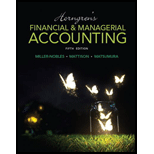
1. a
Bonds: Bonds are long-term promissory notes that are represented by a company while borrowing money from investors to raise fund for financing the operations.
To compute: Purchase
b.
Bonds: Bonds are long-term promissory notes that are represented by a company while borrowing money from investors to raise fund for financing the operations.
To compute: Purchase price of bonds
c.
Bonds: Bonds are long-term promissory notes that are represented by a company while borrowing money from investors to raise fund for financing the operations.
To compute: Purchase price of bonds
d.
Bonds: Bonds are long-term promissory notes that are represented by a company while borrowing money from investors to raise fund for financing the operations.
To compute: Purchase price of bonds
2.
To find: The maturity value of the bonds.
Want to see the full answer?
Check out a sample textbook solution
Chapter 12 Solutions
Horngren's Financial & Managerial Accounting (5th Edition)
- 5 PTSarrow_forwardIn 2011, It cost Parley Corp. $9 per unit to produce part T5. In 2012, it has increased to $12 per unit. In 2012, Southside Company has offered to provide Part T5 for $7 per unit to Westa. As it pertains to the make-or-buy decision, which statement is true?arrow_forwardWhat is its ROEarrow_forward
- Kendall Corporation uses the weighted-average method in its process costing system. The ending work in process inventory consists of 10,000 units. The ending work in process inventory is 100% complete with respect to materials and 60% complete with respect to labor and overhead. If the cost per equivalent unit for the period is $4.00 for materials and $1.50 for labor and overhead, what is the balance of the ending work in process inventory account?arrow_forwardA manufacturer sells a product for $45 to a wholesaler, and the wholesaler sells it to a retailer. The wholesaler's normal markup (based on selling price) is 25%. The retailer prices the item to consumers to include a 33% markup (also based on selling price). What is the selling price to the consumer?arrow_forwardFinancial Accountingarrow_forward
 Excel Applications for Accounting PrinciplesAccountingISBN:9781111581565Author:Gaylord N. SmithPublisher:Cengage Learning
Excel Applications for Accounting PrinciplesAccountingISBN:9781111581565Author:Gaylord N. SmithPublisher:Cengage Learning Financial Accounting: The Impact on Decision Make...AccountingISBN:9781305654174Author:Gary A. Porter, Curtis L. NortonPublisher:Cengage Learning
Financial Accounting: The Impact on Decision Make...AccountingISBN:9781305654174Author:Gary A. Porter, Curtis L. NortonPublisher:Cengage Learning

